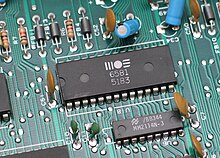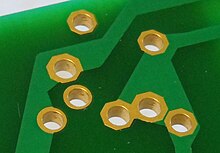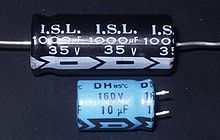86:
598:
162:). Over time, this definition was generalized in contrast to axial leads, and took on its current form. When placed on a board, radial components "stand up" perpendicular, occupying a smaller footprint on sometimes-scarce "board real estate", making them useful in many high-density designs. The parallel leads projecting from a single mounting surface gives radial components an overall "plugin nature", facilitating their use in high-speed automated component insertion ("board-stuffing") machines.
74:
243:
216:
128:
22:
110:(PTH) in order for the components to make contact with the required conductive layers. Plated-through holes are no longer required with SMT boards for making the component connections, but are still used for making interconnections between the layers and in this role are more usually called
174:
on nearby components. Conversely, a radial component can be pressed into service as an axial component by separating its leads as far as possible, and extending them into an overall length-spanning shape. These improvisations are often seen in
260:
on layers immediately below the top layer on multilayer boards since the holes must pass through all layers to the opposite side. To that end, through-hole mounting techniques are now usually reserved for bulkier or heavier components such as
106:(SMT) became popular in the mid 1980s, every component on a typical PCB was a through-hole component. PCBs initially had tracks printed on one side only, later both sides, then multi-layer boards were in use. Through holes became
255:
While through-hole mounting provides strong mechanical bonds when compared to SMT techniques, the additional drilling required makes the boards more expensive to produce. They also limit the available routing area for
165:
When needed, an axial component can be effectively converted into a radial component, by bending one of its leads into a "U" shape so that it ends up close to and parallel with the other lead. Extra insulation with
153:
Radial leads project more or less in parallel from the same surface or aspect of a component package, rather than from opposite ends of the package. Originally, radial leads were defined as more-or-less following a
89:
Close-up view of an electronic circuit board showing component lead holes (gold-plated) with through-hole plating up the sides of the hole to connect tracks on both sides of the board. The holes are circa 1 mm
250:
used for making holes in printed circuit boards. While tungsten-carbide bits are very hard, they eventually wear out or break. Making holes is a considerable part of the cost of a through-hole printed circuit
567:
150:. Axial components do not protrude much above the surface of a board, producing a low-profile or flat configuration when placed "lying down" or parallel to the board.
146:. Axial-leaded components resemble wire jumpers in shape, and can be used to span short distances on a board, or even otherwise unsupported through an open space in
296:
in wire leads, which would impair circuit function. Ultra-compact designs may also dictate SMT construction, even in the prototype phase of design.
284:
Design engineers often prefer the larger through-hole rather than surface mount parts when prototyping, because they can be easily used with
622:
575:
601:
230:
For electronic components with two or more leads, for example, diodes, transistors, ICs, or resistor packs, a range of standard-sized
551:
497:
410:
534:
138:
Components with wire leads are generally used on through-hole boards. Axial leads protrude from each end of a typically
374:
99:
392:
324:
95:
402:
518:
85:
61:
to pads on the opposite side, either by manual assembly (hand placement) or by the use of automated
334:
329:
103:
94:
Through-hole technology almost completely replaced earlier electronics assembly techniques such as
278:
196:
192:
62:
617:
262:
132:
288:. However, high-speed or high-frequency designs may require SMT technology to minimize stray
231:
147:
54:
81:. Axial-lead devices are at upper left, while blue radial-lead capacitors are at upper right
274:
46:
8:
220:
167:
42:
493:
406:
370:
339:
159:
111:
460:
204:
143:
188:
611:
597:
429:
266:
171:
78:
535:"Flexible production cell for led arrays. (Spotlight: electronic displays)"
257:
50:
315:. These components are large enough to be easy to use and solder by hand.
127:
293:
273:
that require the additional mounting strength, or for components such as
139:
30:
73:
304:
289:
285:
242:
184:
176:
300:
247:
215:
200:
180:
58:
568:"Fabrication: Visiting a production line of Kingston memory modules"
366:
308:
77:
Through-hole devices mounted on the circuit board of a mid-1980s
21:
312:
270:
155:
234:
are used, either directly onto the PCB or via a socket.
142:
or elongated box-shaped component, on the geometrical
191:
designs. This is because of difficulties in use with
385:
383:
533:
391:
359:Electronic Packaging: Solder Mounting Technologies
380:
363:Encyclopedia of Materials: Science and Technology
609:
516:
483:
481:
517:Lesser, Roger; Alderton, Megan (2002-01-01).
389:
565:
478:
352:
552:"Component Layout in Placement Processes"
131:Axial- (top) and radial- (bottom) leaded
122:
521:. Mobile Development and Design Magazine
281:that require great strength in support.
241:
223:can have upwards of dozens of leads, or
214:
210:
126:
84:
72:
20:
487:
390:Horowitz, Paul; Hill, Winfield (1989).
193:automated component placement machinery
610:
299:Through-hole components are ideal for
207:resistance in the completed assembly.
158:of a cylindrical component (such as a
41:") is a manufacturing scheme in which
424:
422:
16:Circuit board manufacturing technique
566:Charpentier, Stephane (2010-03-10).
549:
492:. New York: M. Dekker. p. 205.
490:Connections in electronic assemblies
455:
453:
451:
449:
623:Printed circuit board manufacturing
519:"The Future of Commercial Aviation"
13:
554:. Printed Circuit Design & Fab
538:. Canadian Electronics. 2003-03-01
510:
465:wiseGEEK: clear answers for common
419:
237:
14:
634:
602:Hole sizes for through-hole parts
590:
446:
596:
361:in K. H. Buschow et al (eds.),
269:in larger packages such as the
25:Through-hole (leaded) resistors
307:using microprocessors such as
100:second generation of computers
1:
345:
488:Bilotta, Anthony J. (1985).
7:
574:(in French). Archived from
401:(2nd ed.). Cambridge:
325:Point-to-point construction
318:
96:point-to-point construction
10:
639:
550:Khan, Zulki (2010-02-01).
403:Cambridge University Press
68:
467:. Conjecture Corporation
461:"What Is an Axial Lead?"
335:Surface-mount technology
330:Board-to-board connector
279:electromechanical relays
117:
104:surface-mount technology
63:insertion mount machines
263:electrolytic capacitors
170:may be used to prevent
133:electrolytic capacitors
35:through-hole technology
430:"All About Capacitors"
394:The art of electronics
252:
232:semiconductor packages
227:
183:construction, but are
160:ceramic disk capacitor
135:
123:Axial and radial leads
91:
82:
55:printed circuit boards
26:
434:Beavis Audio Research
245:
218:
211:Multiple lead devices
148:point-to-point wiring
130:
88:
76:
24:
108:plated-through holes
221:integrated circuits
199:because of reduced
102:in the 1950s until
286:breadboard sockets
253:
228:
168:heat-shrink tubing
136:
92:
83:
27:
572:PC World (France)
340:Via (electronics)
630:
600:
586:
584:
583:
562:
560:
559:
546:
544:
543:
537:
529:
527:
526:
504:
503:
499:978-0-82477319-9
485:
476:
475:
473:
472:
457:
444:
443:
441:
440:
426:
417:
416:
412:978-0-52137095-0
400:
397:
387:
378:
356:
219:Components like
205:mechanical shock
144:axis of symmetry
638:
637:
633:
632:
631:
629:
628:
627:
608:
607:
593:
581:
579:
557:
555:
541:
539:
532:
524:
522:
513:
511:Further reading
508:
507:
500:
486:
479:
470:
468:
459:
458:
447:
438:
436:
428:
427:
420:
413:
398:
388:
381:
377:, pp. 2708–2709
357:
353:
348:
321:
275:plug connectors
240:
238:Characteristics
213:
189:mass production
125:
120:
71:
37:(also spelled "
17:
12:
11:
5:
636:
626:
625:
620:
606:
605:
592:
591:External links
589:
588:
587:
563:
547:
530:
512:
509:
506:
505:
498:
477:
445:
418:
411:
379:
350:
349:
347:
344:
343:
342:
337:
332:
327:
320:
317:
303:circuits with
267:semiconductors
239:
236:
212:
209:
124:
121:
119:
116:
70:
67:
15:
9:
6:
4:
3:
2:
635:
624:
621:
619:
618:Chip carriers
616:
615:
613:
603:
599:
595:
594:
578:on 2012-04-26
577:
573:
569:
564:
553:
548:
536:
531:
520:
515:
514:
501:
495:
491:
484:
482:
466:
462:
456:
454:
452:
450:
435:
431:
425:
423:
414:
408:
404:
396:
395:
386:
384:
376:
375:0-08-043152-6
372:
368:
364:
360:
355:
351:
341:
338:
336:
333:
331:
328:
326:
323:
322:
316:
314:
310:
306:
302:
297:
295:
291:
287:
282:
280:
276:
272:
268:
264:
259:
258:signal traces
249:
244:
235:
233:
226:
222:
217:
208:
206:
202:
198:
195:, and poorer
194:
190:
186:
182:
178:
173:
169:
163:
161:
157:
151:
149:
145:
141:
134:
129:
115:
113:
109:
105:
101:
97:
87:
80:
79:home computer
75:
66:
64:
60:
56:
52:
51:through holes
49:are inserted
48:
44:
40:
36:
32:
23:
19:
604:at Wikibooks
580:. Retrieved
576:the original
571:
556:. Retrieved
540:. Retrieved
523:. Retrieved
489:
469:. Retrieved
464:
437:. Retrieved
433:
393:
362:
358:
354:
298:
283:
254:
229:
224:
172:shorting out
164:
152:
137:
107:
93:
38:
34:
28:
18:
305:breadboards
301:prototyping
294:capacitance
197:reliability
140:cylindrical
98:. From the
53:drilled in
31:electronics
612:Categories
582:2011-12-30
558:2011-12-30
542:2011-12-30
525:2011-12-30
471:2013-05-16
439:2013-05-16
346:References
290:inductance
248:drill bits
185:deprecated
177:breadboard
57:(PCB) and
47:components
246:A box of
201:vibration
181:prototype
90:diameter.
39:thru-hole
367:Elsevier
319:See also
59:soldered
369:, 2001
309:Arduino
69:History
45:on the
496:
409:
373:
313:PICAXE
271:TO-220
251:board.
156:radius
399:(PDF)
118:Leads
43:leads
494:ISBN
407:ISBN
371:ISBN
292:and
225:pins
203:and
187:for
112:vias
311:or
277:or
265:or
179:or
29:In
614::
570:.
480:^
463:.
448:^
432:.
421:^
405:.
382:^
365:,
114:.
65:.
33:,
585:.
561:.
545:.
528:.
502:.
474:.
442:.
415:.
Text is available under the Creative Commons Attribution-ShareAlike License. Additional terms may apply.



